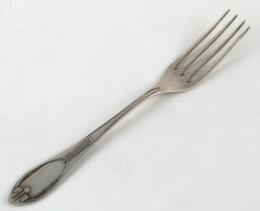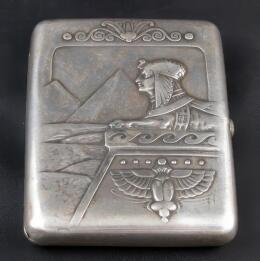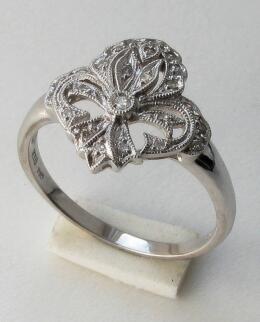Article: Art Deco style
France is rightfully considered the birthplace of the Art Deco style, experts called it a style movement that lasted between two difficult and bloody World Wars. By 1920, this style had gained strength and became widely popular. Jewelers have always belonged to the "caste" of professionals who keenly felt the mood of society, and were a bit of psychologists, understanding the needs of people in each time period. They realized that people need joy, especially women, who had a very hard time enduring all the hardships and hardships of wartime, when they had to replace men. However, along with the idea of creating new jewelry that brings positivity and distracts from heavy thoughts, jewelers realized that these should be fundamentally new products, created in a new and different from all known style. Thus, Art Deco was born, a style combining elements of Art Nouveau, Cubism, Expressionism with a sprinkling of bright decorative elements.
 New ideas found themselves in the strict geometry of lines and forms, the foreground of decorations was given to shining carefully cut precious stones. The unusual at first glance combination of simplicity of forms and luxury of stones, clear geometric designs and shine of luxurious stones - immediately attracted the attention of women, first in France, and then in Europe and America. The Art Deco exhibition, held in Paris in 1925, which presented the latest achievements in the furniture industry, interior design, architecture, the latest products made of glass, metal, ceramics - served as an impetus for the rapid development of the Art Deco style.
New ideas found themselves in the strict geometry of lines and forms, the foreground of decorations was given to shining carefully cut precious stones. The unusual at first glance combination of simplicity of forms and luxury of stones, clear geometric designs and shine of luxurious stones - immediately attracted the attention of women, first in France, and then in Europe and America. The Art Deco exhibition, held in Paris in 1925, which presented the latest achievements in the furniture industry, interior design, architecture, the latest products made of glass, metal, ceramics - served as an impetus for the rapid development of the Art Deco style.
This style is characterized not only by bold and unusual combinations of incompatible materials, but also by bright and flashy combinations of precious and semi-precious stones (sometimes with inclusions of ornamental ones). Jewelry with diamonds, densely "seasoned" with onyx, rubies, emeralds and sapphires, caught the eye. Amethysts, Chinese jade, pearls, turquoise, carnelian and corals suddenly came into fashion. Color combinations became contrasting, bright, had no halftones, which became a distinctive feature of jewelry of those years. Often, it was color that played a key role in the design of the product.
 And the color scheme itself changed fundamentally and unexpectedly. The languid and broken lines of jewelry, the mysterious shimmering shine of "noble" stones creating pastel tones were replaced by clear lines and contrasting colors. The most popular colors were black, white, dark blue, all shades of red, dark yellow, green and metallic (gold and silver). The combination of these colors created unimaginable visual effects, and the commitment to strict geometry of lines was reflected in the shape of the stone cut. Baguette, square, octagon (emerald), triangle and shield came into fashion.
And the color scheme itself changed fundamentally and unexpectedly. The languid and broken lines of jewelry, the mysterious shimmering shine of "noble" stones creating pastel tones were replaced by clear lines and contrasting colors. The most popular colors were black, white, dark blue, all shades of red, dark yellow, green and metallic (gold and silver). The combination of these colors created unimaginable visual effects, and the commitment to strict geometry of lines was reflected in the shape of the stone cut. Baguette, square, octagon (emerald), triangle and shield came into fashion.
Another feature of this style was the difference in neck jewelry. Necklaces and chokers became a single "layer" of stones or metal, and, as a rule, were not decorated with pendants and charms. An exquisite decoration appeared - a tassel brooch. Elegant ladies in daytime clothes used an unusually long thread of artificial pearls or heavy solid beads of metal or stones. The appearance of a brooch consisting of two parts with a clasp in the form of a clip, which was used to pin troikars, changed the styles of dresses and evening gowns.
 The distinctive features of this new look were bare arms, brightly and provocatively painted lips, short, boyishly angular haircuts, and scandalously short dresses. This new, almost boyish image needed to be emphasized with equally provocative jewelry. And long, loose necklaces, elongated teardrop-shaped earrings, bold rings, heavy flat bracelets, which were worn in large quantities on both hands, were the best fit for this look. The bracelets were made in two styles - in the form of elongated ribbons imitating lace, and wide arrays that amazingly emphasized the sophistication of a woman's wrist.
The distinctive features of this new look were bare arms, brightly and provocatively painted lips, short, boyishly angular haircuts, and scandalously short dresses. This new, almost boyish image needed to be emphasized with equally provocative jewelry. And long, loose necklaces, elongated teardrop-shaped earrings, bold rings, heavy flat bracelets, which were worn in large quantities on both hands, were the best fit for this look. The bracelets were made in two styles - in the form of elongated ribbons imitating lace, and wide arrays that amazingly emphasized the sophistication of a woman's wrist.
The difference in jewelry was also its variety. Flat belts and watches, which were abundantly decorated with precious stones, were added to jewelry that adorned any clothing, and they prevailed on bracelets and watch cases. These accessories also became a bright addition to women's outfits.
At the beginning of the Art Deco style, jewelers began to use glass, chrome elements, colored enamels and even plastic in their works, bright and flashy colors dominated. However, the masters quickly realized that the "lost generation" desperately needed an illusory feeling of a prosperous life, and this could only be created with gold, platinum and precious stones. Therefore, noble metals and stones became the accent of all jewelry, and everything else was just an auxiliary entourage.
 New ideas found themselves in the strict geometry of lines and forms, the foreground of decorations was given to shining carefully cut precious stones. The unusual at first glance combination of simplicity of forms and luxury of stones, clear geometric designs and shine of luxurious stones - immediately attracted the attention of women, first in France, and then in Europe and America. The Art Deco exhibition, held in Paris in 1925, which presented the latest achievements in the furniture industry, interior design, architecture, the latest products made of glass, metal, ceramics - served as an impetus for the rapid development of the Art Deco style.
New ideas found themselves in the strict geometry of lines and forms, the foreground of decorations was given to shining carefully cut precious stones. The unusual at first glance combination of simplicity of forms and luxury of stones, clear geometric designs and shine of luxurious stones - immediately attracted the attention of women, first in France, and then in Europe and America. The Art Deco exhibition, held in Paris in 1925, which presented the latest achievements in the furniture industry, interior design, architecture, the latest products made of glass, metal, ceramics - served as an impetus for the rapid development of the Art Deco style.This style is characterized not only by bold and unusual combinations of incompatible materials, but also by bright and flashy combinations of precious and semi-precious stones (sometimes with inclusions of ornamental ones). Jewelry with diamonds, densely "seasoned" with onyx, rubies, emeralds and sapphires, caught the eye. Amethysts, Chinese jade, pearls, turquoise, carnelian and corals suddenly came into fashion. Color combinations became contrasting, bright, had no halftones, which became a distinctive feature of jewelry of those years. Often, it was color that played a key role in the design of the product.
 And the color scheme itself changed fundamentally and unexpectedly. The languid and broken lines of jewelry, the mysterious shimmering shine of "noble" stones creating pastel tones were replaced by clear lines and contrasting colors. The most popular colors were black, white, dark blue, all shades of red, dark yellow, green and metallic (gold and silver). The combination of these colors created unimaginable visual effects, and the commitment to strict geometry of lines was reflected in the shape of the stone cut. Baguette, square, octagon (emerald), triangle and shield came into fashion.
And the color scheme itself changed fundamentally and unexpectedly. The languid and broken lines of jewelry, the mysterious shimmering shine of "noble" stones creating pastel tones were replaced by clear lines and contrasting colors. The most popular colors were black, white, dark blue, all shades of red, dark yellow, green and metallic (gold and silver). The combination of these colors created unimaginable visual effects, and the commitment to strict geometry of lines was reflected in the shape of the stone cut. Baguette, square, octagon (emerald), triangle and shield came into fashion.Another feature of this style was the difference in neck jewelry. Necklaces and chokers became a single "layer" of stones or metal, and, as a rule, were not decorated with pendants and charms. An exquisite decoration appeared - a tassel brooch. Elegant ladies in daytime clothes used an unusually long thread of artificial pearls or heavy solid beads of metal or stones. The appearance of a brooch consisting of two parts with a clasp in the form of a clip, which was used to pin troikars, changed the styles of dresses and evening gowns.
 The distinctive features of this new look were bare arms, brightly and provocatively painted lips, short, boyishly angular haircuts, and scandalously short dresses. This new, almost boyish image needed to be emphasized with equally provocative jewelry. And long, loose necklaces, elongated teardrop-shaped earrings, bold rings, heavy flat bracelets, which were worn in large quantities on both hands, were the best fit for this look. The bracelets were made in two styles - in the form of elongated ribbons imitating lace, and wide arrays that amazingly emphasized the sophistication of a woman's wrist.
The distinctive features of this new look were bare arms, brightly and provocatively painted lips, short, boyishly angular haircuts, and scandalously short dresses. This new, almost boyish image needed to be emphasized with equally provocative jewelry. And long, loose necklaces, elongated teardrop-shaped earrings, bold rings, heavy flat bracelets, which were worn in large quantities on both hands, were the best fit for this look. The bracelets were made in two styles - in the form of elongated ribbons imitating lace, and wide arrays that amazingly emphasized the sophistication of a woman's wrist.The difference in jewelry was also its variety. Flat belts and watches, which were abundantly decorated with precious stones, were added to jewelry that adorned any clothing, and they prevailed on bracelets and watch cases. These accessories also became a bright addition to women's outfits.
At the beginning of the Art Deco style, jewelers began to use glass, chrome elements, colored enamels and even plastic in their works, bright and flashy colors dominated. However, the masters quickly realized that the "lost generation" desperately needed an illusory feeling of a prosperous life, and this could only be created with gold, platinum and precious stones. Therefore, noble metals and stones became the accent of all jewelry, and everything else was just an auxiliary entourage.
